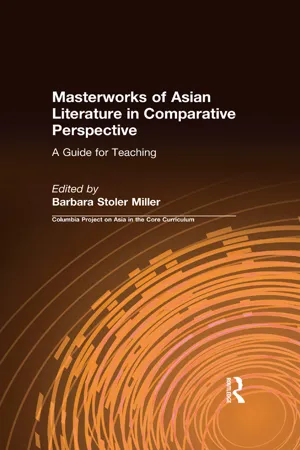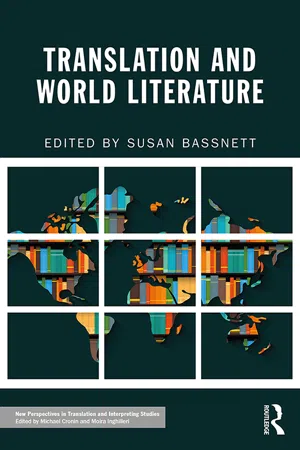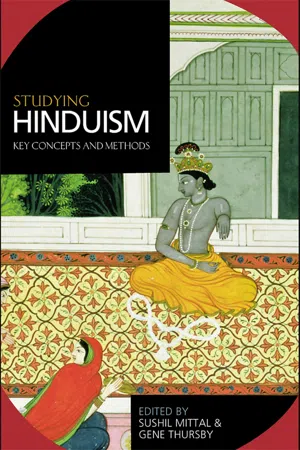Indian Literature
Indian literature encompasses a rich and diverse body of written works in various languages, including Sanskrit, Tamil, Hindi, Bengali, and many others. It reflects the cultural, social, and historical experiences of the Indian subcontinent, addressing a wide range of themes and genres such as epics, poetry, drama, and fiction. Indian literature has made significant contributions to world literature and continues to evolve with contemporary voices and perspectives.
4 Key excerpts on "Indian Literature"
- eBook - ePub
Masterworks of Asian Literature in Comparative Perspective: A Guide for Teaching
A Guide for Teaching
- Barbara Stoler Miller(Author)
- 2016(Publication Date)
- Routledge(Publisher)
...Princeton: Princeton University Press, 1990. Dimock, Edward C., et al. The Literatures of India: An Introduction. Chicago: University of Chicago Press, 1974. Embree, Ainslie, ed. Sources of Indian Tradition. Vol. 1, From the Beginning to 1800. 2d ed. New York: Columbia University Press, 1988. Hay, Stephen, ed. Sources of Indian Tradition. Vol. 2, Modem India and Pakistan. 2d ed. New York: Columbia University Press, 1988. Warder, A. K. Indian Kāvya Literature. 4 vols. Delhi: Motilal Banarsidass, 1972–83. A NOTE ON MODERN Indian Literature David Rubin The literatures of India in the twentieth century, and particularly since independence in 1947, have flourished both in English and in the many Indian regional languages. Fiction and poetry are probably the most widely cultivated genres, though drama and criticism are gaining in both frequency and maturity. Only a small amount of this writing has been translated into English. Therefore, ironically, it is mainly works written originally in English, called Indo-Anglian, that have become well known in the West. Both the abundance and the variety of twentieth-century Indian Literature make a brief survey of it next to impossible. Getting an accurate overall picture of writing in the entire Subcontinent is rendered still more complicated by the fact that few critics command more than two or three of the many regional languages in which worthwhile literature is being produced...
- eBook - ePub
- Susan Bassnett, Susan Bassnett(Authors)
- 2018(Publication Date)
- Routledge(Publisher)
...At the same time, it may be seriously doubted whether it constitutes even 5% of the corpus of works composed in the 24 major languages of India over the last one or two or three millennia (as may be the case for each of the languages.). Indian Literature is perhaps like an elephant, and all of us who speak about it in the original or in translation are like the six blind men in the old story, each of whom gets hold of some random part of the beast and thinks it to be the whole. To change metaphors again, the proof of the pudding of any national literature in English translation is just what and how much of it finds wider circulation and is picked up to be part of the canon of World Literature. Here, only a sample of such a canon will be examined, by looking at the Longman Anthology of World Literature in six volumes amounting to approximately 6,508 pages (Damrosch 2004), and the space Indian Literature occupies in it. In Volume A (3500 BCE–500 CE, but the chronology spans are often overlapping as will be seen below), out of a total of 1390 pages, Indian Literature fills 240 pages, which is next only to Greek (approximately 600 pages). In Volume B (200–1492), however, as if to atone for the rather generous recognition accorded it in Volume A, Indian Literature is not granted even a single page out of 1354 pages (if one does not count a Chinese monk briefly describing travels to India by earlier monks from that country, or a short extract from the Tibetan Book of the Dead). Thus, after Kalidasa (4th–5th century) in Volume A, the next Indian author we come across is Basavanna (1106– c.1167) in Volume C. It is as if Indian Literature went into a deep coma for about seven hundred years – which of course is not the case at all, for the epic poets Bharavi (6th century) and Magha (7th century), the novelist Banabhatta (7th century), the playwright Bhavabhuti (8th century), and the lyric poet Jayadeva (12th century), all belong to the front rank of Sanskrit authors...
- eBook - ePub
Indian Genre Fiction
Pasts and Future Histories
- Bodhisattva Chattopadhyay, Aakriti Mandhwani, Anwesha Maity(Authors)
- 2018(Publication Date)
- Routledge India(Publisher)
...Introduction Indian genre fiction – languages, literatures, classifications Bodhisattva Chattopadhyay, Aakriti Mandhwani and Anwesha Maity This book was first conceived from reconfigurations advanced by the non-Anglocentrism manifesto, which sought to extend critical scholarship on science fiction and fantasy to texts produced in non-Anglophone contexts. 1 The manifesto proposed new approaches to understanding the translations industry and the distribution and reception of genres, along with alternative ways of conceptualising genre themes and motifs, while reconstructing the historical matrix to analyse differences and similarities between genres. The manifesto went on to receive favourable popular support, generating significant conversation in the blogosphere, forums, and on Twitter, crowned by winning the Strange Horizons Readers’ Poll Award for best non-fiction article in 2013. This success alerted the editors of the current volume that perhaps it was necessary not only to propose such steps, but also to undertake a project that could realise some of the ambitions of the manifesto. Subsequent discussions between the editors regarding other genres, such as detective fiction and romance, led us to conceive of a more comprehensive approach to the study of genre fiction in Indian publishing spaces. This would involve compiling genre fiction criticism across Indian languages and genres, something which had not been attempted before. So what exactly is genre fiction in the Indian context, and what makes describing it problematic? Genre as a term generally has two distinct yet intertwined uses. The first of these refers to the formal choice of aesthetic presentation or genre as description of narrative form: novel, short story, poem, drama, and so on...
- eBook - ePub
Studying Hinduism
Key Concepts and Methods
- Sushil Mittal, Gene Thursby(Authors)
- 2009(Publication Date)
- Routledge(Publisher)
...Fictional representations of Hinduism in the colonial era tend to be preoccupied with questions of what Hinduism should be and how Hindu tradition should be reformed to further the cause of social justice and the aims of a secular nationalist movement. In the postcolonial era, such novelists as Salman Rushdie, Ashok K. Banker, and others have adapted and reinvented elements of Hindu mythology, especially the Rāmāyaṇa, using the conventions of magical realism and science fi ction, to place them in new contexts. Other writers, especially such feminist novelists as Githa Hariharan and Manju Kapur, have dealt with the ways in which some elements of traditional Hinduism have been reactivated with the reemergence of the militant ideology of postcolonial Hindu nationalism. The novels referred to in this chapter can be instructively read as providing a historical sketch of the evolution of Hinduism in the context of the political upheavals of the Indian subcontinent leading up to and after independence. Many of these novels also provide rich material for lay readers and those interested in learning about Hindu tradition as it is lived and felt in the everyday lives of more than 800 million Hindus in India and elsewhere. Hinduism in Early Indian Fiction (1855–1955) It is generally accepted that the modern novel emerged in Europe in the eighteenth century (Watt 1957), though there were certainly in Europe traditions of prose writing and elsewhere that preceded it. Before the advent of British colonial rule in the mid-eighteenth century, the overwhelming bulk of imaginative literature in India was composed in verse form and recited orally. Much of it was in some sense devotional and tied to the Hindu tradition, though there were exceptions to this rule. Modern prose fiction was made possible by the introduction of the printing press, starting in Bengal around 1800 (Sen 1960: 178–79)...



